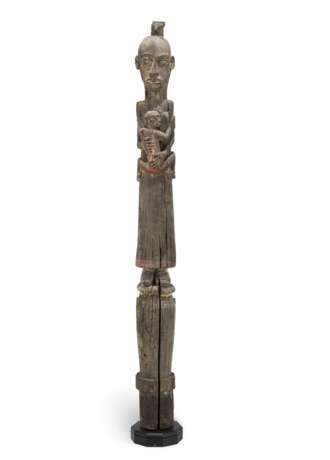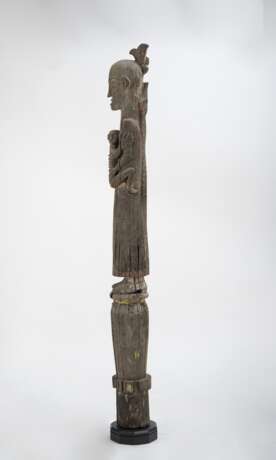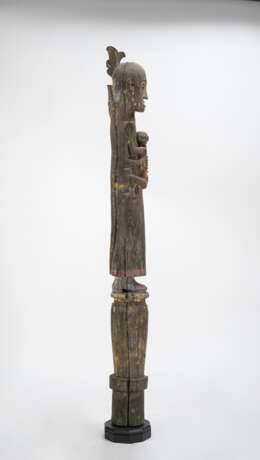ID 1218048
Lot 1531 | Schutzfigur ''hampatong'' aus Eisenholz
Estimate value
€ 5 000 – 8 000
H. 182 cm (o.S.)
Diese Holzskulptur hampatong aus Borneo ist vollplastisch aus einem Stück Eisenholz (belian) geschnitzt. Es handelt sich darstellerisch um eine (durch den Kopfschmuck als solche ausgewiesene) adlige Frau, die auf einer Graburne steht und ein Kind hält. Diese Konstellation verweist charmant auf die zyklische Erneuerung des Lebens über die Generationen. Hampatong nennt man verallgemeinernd Ahnen- und Schutz-Figuren aus sehr hartem Holz, die von den Dayak-Ethnien auf Borneo als Erinnerungs-Skulpturen an Verstorbene auf Begräbnisplätzen oder als Wächter vor den Langhäusern aufgestellt werden. Der Begriff hampatong (bei Ngadju) kapatong (bei Kajan) oder tempatong (bei Ot Danun) bezieht sich auf anthropomorphe Figuren aus hartem, dauerhaftem Holz. Hampatong leitet sich von dem Dayak-Wortstamm patong ab, was „Statue“ bedeutet. Wahrscheinlich steht die Figur mit einem namensgebenden Festival oder einer erfolgreichen kajaw (Kriegszug, Kopfjagd) anlässlich der Geburt eines/einer künftigen Adligen in Verbindung. Das Kind wird im übertragenen Sinn erst wirklich geboren, wenn der Ehemann einen Kopf erbeutet hat. So wird unter Beweis gestellt, dass Leben in die Jenseitswelt entsendet wurde, denn es muss innerhalb der zyklischen, landwirtschaftlich bestimmten Erneuerungs-Kosmologie der Dayak erst etwas vergehen, ehe etwas Neues entstehen kann. Dieses genommene Leben kann dann im Rahmen der Übergangsrituale umgewidmet werden. Wahrscheinlich handelt es sich bei dem Holz um Eusideroxylon zwageri, ein Lorbeergewächs, das auf Borneo und Sumatra gedeiht. Als Eisenholz werden viele tropische Hartholzarten bezeichnet, auf Borneo bezeichnet das Wort jedoch spezifisch das belian-Holz. Das Holz weist eine extreme Dichte auf und erfordert für die Bearbeitung Werkzeuge aus sehr gutem Stahl, da das Werkzeug schnellem Verschleiß ausgesetzt ist - mit ein Grund für die hochstehende Schmiede- und Härtetechnik von Klingen auf Borneo.
Aus einer alten deutschen Privatsammlung, seit den 1950er Jahren gesammelt - Minim. Altersspuren, partiell kleine Best. , Altersrisse und Spuren von polychromer Fassung, montiert
| Auction house category: | Ethnographic tribal art |
|---|
| Auction house category: | Ethnographic tribal art |
|---|
| Address of auction |
Nagel Auktionen GmbH Neckarstrasse 189 - 191 70190 Stuttgart Germany | ||||||||||||||
|---|---|---|---|---|---|---|---|---|---|---|---|---|---|---|---|
| Preview | |||||||||||||||
| Phone | +49 (0)711 649 690 | ||||||||||||||
| Fax | +49 (0)711 649 69696 | ||||||||||||||
| Buyer Premium | 29,5% | ||||||||||||||
| Conditions of purchase | Conditions of purchase | ||||||||||||||
| Business hours | Business hours
|






